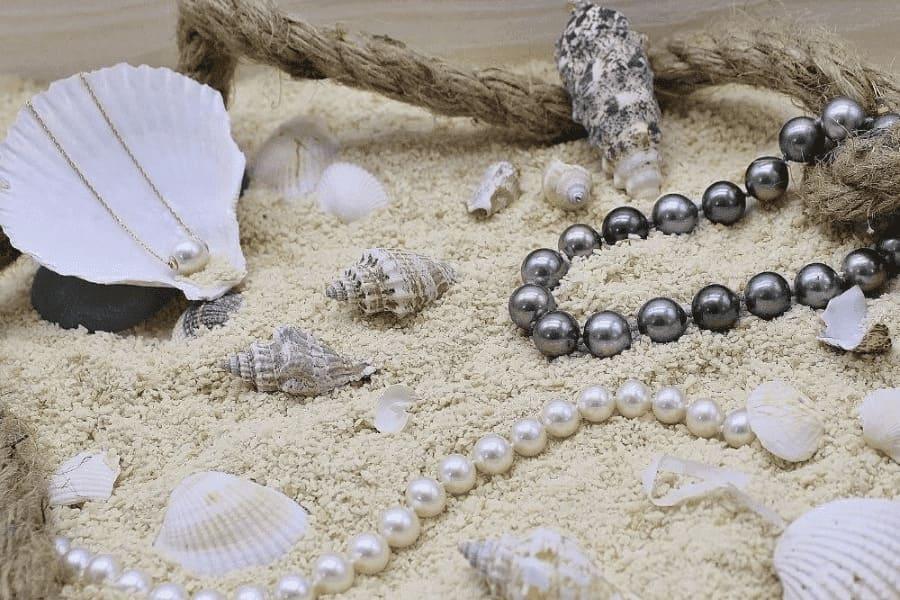Key Takeaways
- Cultured pearls are products of human intervention. They are hard, large and shiny. So, they are often chosen to make jewelry that is worn often.
- Freshwater pearls are cultivated in lakes, rivers or ponds. They are recognized by their variety of shapes and colors.
- The differences in the environment in which they are cultivated and in the formation technique result in the difference between cultured pearls and freshwater pearls , in terms of origin, formation, size, shape, color and texture.
- Cultured pearls have some advantages over freshwater pearls, such as large size and durability.
What is a Cultured Pearl?
Unlike natural pearls, cultured pearls are a human creation. Humans intervene in the creation of pearls by inserting a nucleus or small irritant into oysters and mussels to produce nacre. This nacre is composed of calcium carbonate and conchiolin and it influences the shine and color of the pearl.
Cultured pearls are mainly grown in pearl farms with controlled conditions. The quality of the pearls is determined by the quality of the nucleus and the length of time the oysters are maintained
What is a Freshwater Pearl?
Freshwater pearls are also created by a technique similar to those of culture. Man introduces a small piece of tissue or mother-of-pearl into a mollusk which will then develop mother-of-pearl and form the pearl. Indeed, the mollusks that produce freshwater pearls live mainly in lakes, rivers or ponds.
Unlike other types of pearls, freshwater pearls are usually created without a solid nucleus, so they are composed entirely of nacre. Therefore, these pearls have a softer texture, a diverse shape, and a wide range of colors.

Freshwater pearls come in a variety of colors
What is the difference between cultured pearl and freshwater pearl?
Cultured pearls and freshwater pearls are two of the most popular types in the pearl world. In fact, they are commonly used in jewelry production. These pearls seem similar at first glance but they have many different characteristics in terms of source, formation, texture, size, and color.
Source
The first difference between cultured pearl and freshwater pearl is their origin. Cultured pearls are mainly created by mollusks living in oceans and seas, for example Tahitian pearls or Akoya pearls.
In contrast, freshwater pearls are usually cultivated in rivers, lakes or ponds. China is one of the largest producers of freshwater pearls in the world.
Training
Although both types of pearls are formed with human intervention, there are many differences in their formation. As for cultured pearls, a solid nucleus is introduced into the oyster. The nacre is deposited around it for months, or even years.
Freshwater pearls, on the other hand, are often produced without a solid nucleus. A small piece of tissue is inserted into the mollusk, and the nacre is deposited around this tissue. The difference in the formation of the pearls results in the difference in their shapes and colors.
Texture
The difference in the formation of these types of pearls explains their distinct textures. Indeed, cultured pearls are harder and shinier. Their surface is also smoother. Thanks to this, cultured pearl jewelry has greater durability.
On the other hand, freshwater pearls are known for their softer texture. This, in fact, makes them more susceptible to scratches. But one of the benefits of freshwater pearls is their beautiful internal glow.

The surface of cultured pearls is smoother
Size and shape
One difference between cultured pearls and freshwater pearls is their size and shape. Normally, cultured pearls are larger than freshwater pearls. For example, South Sea pearls can reach a diameter of 20mm. In addition, their shape is often perfectly round due to the solid core.
Conversely, freshwater pearls are regularly smaller. Their average size varies from 5 to 7 mm. In terms of shape, these pearls have several shapes, including round and baroque. This is the result of different natural conditions in which they are cultivated.
Color
In terms of color, cultured pearls do not have a diverse color but their color is intense. For example, Akoya pearls are often white or cream while Tahitian pearls are black and green.
As for freshwater pearls, they have a variety of colors, ranging from white and pink to purple and black. This diversity results from the different nature of the mollusks as well as the cultivation technique.
Advantages of Cultured Pearl Over Freshwater Pearl
Compared to freshwater pearls, cultured pearls have some notable advantages. First, these pearls are larger than freshwater ones. So, they are perfect choices for making valuable jewelry. Then, we must mention the durability of cultured pearls. This characteristic makes them more resistant to shocks and scratches.
However, freshwater pearls also have some advantages. They are less expensive than cultured ones. In addition, these pearls offer a variety of shapes and colors. They are well suited for people who want to own pearls that are more affordable but still elegant.
If you are looking for high quality pearl jewelry, visit Gitsel B house to discover our new collection!

